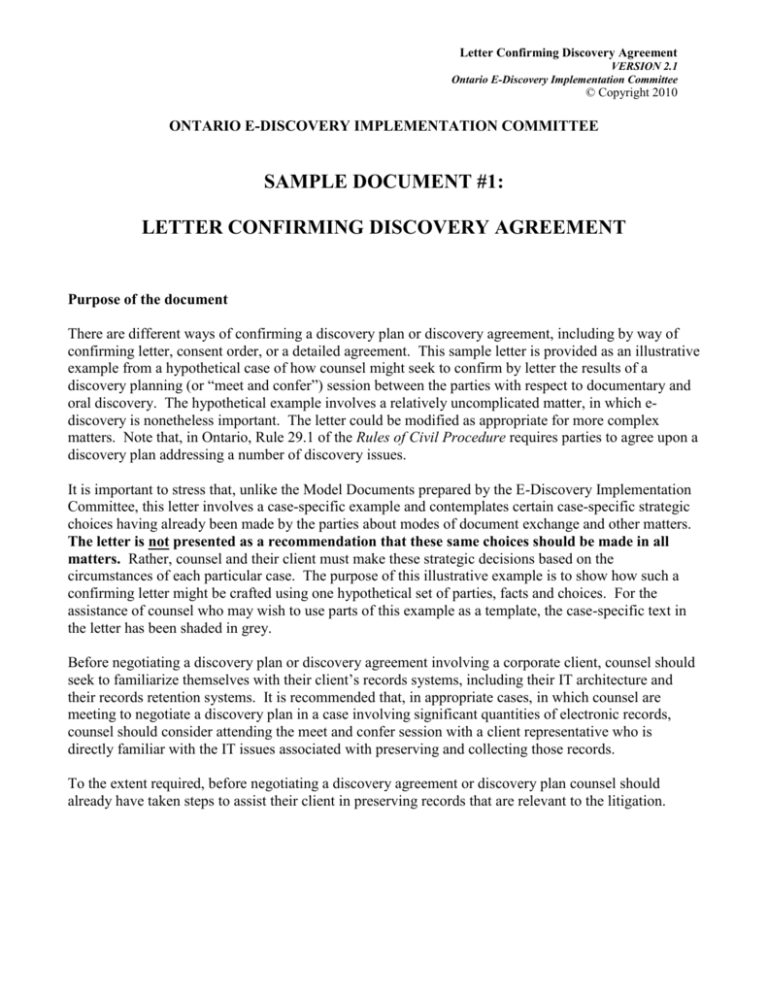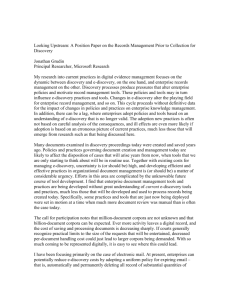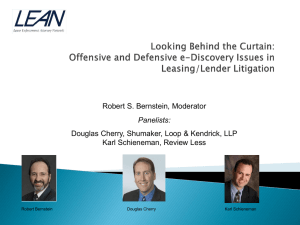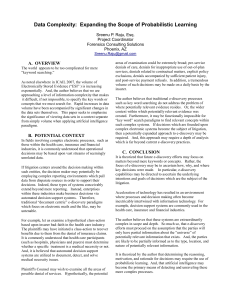
Letter Confirming Discovery Agreement
VERSION 2.1
Ontario E-Discovery Implementation Committee
© Copyright 2010
ONTARIO E-DISCOVERY IMPLEMENTATION COMMITTEE
SAMPLE DOCUMENT #1:
LETTER CONFIRMING DISCOVERY AGREEMENT
Purpose of the document
There are different ways of confirming a discovery plan or discovery agreement, including by way of
confirming letter, consent order, or a detailed agreement. This sample letter is provided as an illustrative
example from a hypothetical case of how counsel might seek to confirm by letter the results of a
discovery planning (or “meet and confer”) session between the parties with respect to documentary and
oral discovery. The hypothetical example involves a relatively uncomplicated matter, in which ediscovery is nonetheless important. The letter could be modified as appropriate for more complex
matters. Note that, in Ontario, Rule 29.1 of the Rules of Civil Procedure requires parties to agree upon a
discovery plan addressing a number of discovery issues.
It is important to stress that, unlike the Model Documents prepared by the E-Discovery Implementation
Committee, this letter involves a case-specific example and contemplates certain case-specific strategic
choices having already been made by the parties about modes of document exchange and other matters.
The letter is not presented as a recommendation that these same choices should be made in all
matters. Rather, counsel and their client must make these strategic decisions based on the
circumstances of each particular case. The purpose of this illustrative example is to show how such a
confirming letter might be crafted using one hypothetical set of parties, facts and choices. For the
assistance of counsel who may wish to use parts of this example as a template, the case-specific text in
the letter has been shaded in grey.
Before negotiating a discovery plan or discovery agreement involving a corporate client, counsel should
seek to familiarize themselves with their client’s records systems, including their IT architecture and
their records retention systems. It is recommended that, in appropriate cases, in which counsel are
meeting to negotiate a discovery plan in a case involving significant quantities of electronic records,
counsel should consider attending the meet and confer session with a client representative who is
directly familiar with the IT issues associated with preserving and collecting those records.
To the extent required, before negotiating a discovery agreement or discovery plan counsel should
already have taken steps to assist their client in preserving records that are relevant to the litigation.
2
Letter Confirming Discovery Agreement
VERSION 2.1
Ontario E-Discovery Implementation Committee
© Copyright 2010
Proportionality
In any legal proceeding, the parties should ensure that all steps taken in the discovery process are
proportionate, taking into account, among other things, the importance and complexity of the case, the
amounts and interests at stake, and the costs, delay, burden and benefit associated with each step.
The principle of proportionality is relevant, in the first instance, in determining the extent to which it is
useful or necessary to confirm the results of a meet and confer session in a letter, or in a formal written
agreement or a consent order. For a model discovery agreement, see Model Document #1: Discovery
Agreement, Model Document #9A: Discovery Plan (Long Form) and Model Document #9B: Discovery
Plan (Short Form).
The proportionality principle is also relevant in identifying the issues on which agreement should be
sought in a discovery plan or discovery agreement, and in determining the scope of the documentary
discovery obligations to which the parties should agree.
Annotations
Annotations are included at various points throughout the model document, identifying issues that the
parties may wish to consider. Many of the annotations refer to The Sedona Canada Principles
Addressing Electronic Discovery (the “Sedona Canada Principles”). Civil litigants in Ontario are
required, pursuant to Rule 29.1 of the Rules of Civil Procedure, to consult and have regard to the Sedona
Canada Principles in preparing a discovery plan for an action. The Sedona Canada Principles are a set
of national guidelines for e-discovery in Canada, which reflect both existing legal principles and a set of
identified best practices. A copy of the Sedona Canada Principles may be downloaded from
www.thesedonaconference.org, where they are found under the list of publications for Working Group
7.
The annotations are included for the benefit of counsel, who will presumably wish to delete the
annotations, or to incorporate parts of them into the text of the letter, prior to sending the letter to the
opposing party.
Note regarding use of this document
This memorandum and all of the EIC’s model documents and other publications are available on the
Ontario Bar Association's website at:
http://www.oba.org/En/publicaffairs_en/E-Discovery/model_precedents.aspx
This model document has been prepared and made available to the public by the EIC for
informational purposes. It is not provided as legal or technical advice and should not be relied upon
as such.
Publications of the EIC are copyrighted by the Ontario E-Discovery Implementation Committee and
all rights are reserved. Individuals may download these publications for their own use at no charge.
3
Letter Confirming Discovery Agreement
VERSION 2.1
Ontario E-Discovery Implementation Committee
© Copyright 2010
Law firms and other organizations may download these publications and make them available
internally for individual use within the firm or organization. EIC publications may be republished,
copied or reprinted at no charge for non-profit purposes. Organizations and individuals may provide
a link to the publications on the internet without charge provided that proper attribution to the
Ontario E-Discovery Implementation Committee is included. For further information, or to request
permission to republish, copy or reprint for commercial profit, contact the Chair of the Committee,
David Outerbridge, at douterbridge@torys.com.
Feedback on EIC materials
The EIC welcomes comments on all of its model documents and other publications. Any comments
or suggestions can be provided to Michele A. Wright at mwright4@toronto.ca.
4
Letter Confirming Discovery Agreement
VERSION 2.1
Ontario E-Discovery Implementation Committee
© Copyright 2010
January 4, 2009
VIA EMAIL
Bob Jones
Barrister and Solicitor
1000 1st Avenue West
Suite 400
Smithville, Ontario
L1A 1A1
Dear Mr. Jones:
Re:
ABC Corp. Ltd. v. DEF Co. Inc.
Agreed Discovery Plan1
I confirm that our clients have agreed to the following discovery plan with respect to: (1) the
preservation, disclosure and production of electronic documents, and of paper documents in
electronic format; and (2) oral discovery.2
1
2
Principle #4 of the Sedona Canada Principles states that “Counsel and parties should meet and confer
as soon as practicable and on an ongoing basis, regarding the identification, preservation, collection,
review and production of electronically stored information.” This document is designed to confirm
those points on which the parties reach agreement. The parties may wish to have several meet and
confer sessions over time (as suggested in Principle #4), and to enter into more than one agreement.
The parties may also wish to use only some parts of this model confirming letter at any one time.
Rule 29.1 of the Ontario Rules of Civil Procedure requires parties to agree upon a written discovery
plan for the action that addresses the intended scope of documentary discovery taking into account
proportionality issues, dates for service of affidavits of documents, information regarding the timing,
costs and manner of production of documents, the names of discovery witnesses, information
regarding the timing and length of examinations for discovery, and any other information intended to
result in the expeditious and cost-effective completion of the discovery process in a manner that is
proportionate to the importance and complexity of the action. The rule requires parties to consult and
have regard to the Sedona Canada Principles in preparing the discovery plan.
5
Letter Confirming Discovery Agreement
VERSION 2.1
Ontario E-Discovery Implementation Committee
© Copyright 2010
Preservation3
a) Location of information
We have agreed that your client’s relevant documents are likely stored at the company's location
at 100 South Street in Toronto, in paper and electronic files that are in the physical control of
Bob Smith, Alex Smythe and Frances Smitt. Each of these individuals uses a desktop computer
and a Blackberry device. Messages on each of the Blackberry devices are routed through the
company's server using Microsoft Exchange Server. Relevant documents may be contained on
any of these individuals’ computers, as well as on the company's network server, where
documents are organized in a simple Windows directory hierarchy.
We have also agreed that our client’s relevant documents are likely stored at the company's
location at 200 North Street in Ottawa, in paper and electronic files that are in the physical
control of Zane Grey and Jane Grey. Each of these individuals uses a desktop computer and a
Blackberry device. Each of the Blackberry devices operates on a peer-to-peer basis, that is,
without the message being intercepted and/or recorded by the company server. Relevant
documents may be contained on either of these individuals’ desktops, at Rogers (the provider of
the Blackberry service) or on the company server. Documents on the company server are
organized in a simple Windows directory hierarchy. The company uses EasyBooks for its
financial record-keeping, and this application can produce reports containing the information that
will be relevant in this action.
b) General parameters
We have agreed that relevant documents will likely be in the form of e-mail messages,
correspondence, memoranda, Excel spreadsheets and financial information relating to sales and
commissions.
We have also agreed that the relevant date range is January 1, 2005 to December 31, 2007, and
to limit documentary discovery for the time being to relevant information created or utilized
within that period.
c) Steps to be taken to preserve information
3
Principle #3 of the Sedona Canada Principles states that “As soon as litigation is reasonably
anticipated, parties must consider their obligation to take reasonable and good faith steps to preserve
potentially relevant electronically stored information.” The Sedona Canada Principles recognize that
“it is unreasonable to expect organizations to take every conceivable step to preserve all electronically
stored information that may be potentially relevant.” Comment 3.f states that “a reasonable inquiry
based on good faith to identify and preserve active and archival data should be sufficient.” The parties
should therefore consider and discuss how and where relevant information can be preserved in the
most efficient and cost effective manner.
6
Letter Confirming Discovery Agreement
VERSION 2.1
Ontario E-Discovery Implementation Committee
© Copyright 2010
We have agreed that our respective clients will immediately suspend any practices by which
relevant documents or information may be automatically or manually disposed of, deleted or
archived. This includes, but is not limited to, the automatic deletion or destruction of e-mail
messages and paper documents.
We reached the following agreement with respect to backup media: Our client’s information
system is backed up by virtue of a number of redundant drives. Our client will include all of
these drives in its performance of this preservation protocol. You advised me that your client
backs up its server on a set of magnetic tapes that are cycled every seven days. Your client will
remove the current set of tapes from the current practice of cycling and will preserve these tapes
as they currently exist. [Alternatively: We have agreed not to include backup media within the
scope of the preservation protocol.]4
Our client will also contact Rogers immediately to advise them of the requirement to preserve
whatever information is within their power, possession or control with respect to e-mail
messages sent or received by the above-mentioned individuals. We will advise you of their
response within 10 days. We will also request production of the information from them, and
disclose and produce any relevant, non-privileged documents to you as required.
For preservation purposes, each of our respective clients will make forensic copies of the drives
contained in the companies’ servers, and in each of the desktop computers used by the five
individuals named above.5
We have agreed that all of these steps to preserve relevant information will be taken within the
next 10 days. By January 15, 2009 you and I will confirm to each other that all of these steps
have been taken.6
4
5
6
Relying upon backup media in order to locate relevant records is generally costly and inefficient.
Backup media should be preserved only where they contain unique information that cannot otherwise
be obtained, or where other special circumstances apply. This paragraph should be drafted to reflect
the circumstances of the specific case.
The utility and cost efficiency of making forensic copies of drives depends on the circumstances of the
case. In less complicated matters such as that contemplated by this model confirming letter, forensic
copying can be a relatively simple and inexpensive method of ensuring complete and accurate
preservation of all relevant documents. Note, though, that Comment 4.c of the Sedona Canada
Principles suggests that “[w]hile the making of bit-level images of hard drives is useful in selective
cases for the preservation phase, the further processing of the total contents of the drive should not be
required unless the nature of the matter warrants the cost and burden. Making forensic image backups
of computers is only the first step in a potentially expensive, complex, and difficult process of data
analysis. It can divert litigation into side issues involving the interpretation of ambiguous forensic
evidence.” Note too that it is difficult in practice to make a forensic copy of a server, as servers are
typically not able to be brought out of service for copying.
The parties may wish to enter into a more detailed preservation agreement than that contemplated in
this section. For this purpose, see for example Model Document #2: Preservation Agreement.
7
Letter Confirming Discovery Agreement
VERSION 2.1
Ontario E-Discovery Implementation Committee
© Copyright 2010
Disclosure and Production7
a) Searching for documents and information
You advised me that your client uses an indexing application called EasyReach that has the
capability of searching by word across the entire network from any desktop on which it is
installed. As I indicated, EasyReach does search publicly available information across the
network, but not private information such as e-mail messages within a particular mailbox. In
order to search within an individual's mailbox, the search must be conducted from the
individual’s workstation.
I confirm that you will conduct a search of all documents and information contained on your
client’s network, including the personal computers of the individuals named above, using the
following search parameters:8
[search parameters]
Our client does not have a search application installed on its network. For the purpose of
searching for relevant information, they intend to install an application called dtSearch, which
has capabilities similar to but more extensive than EasyReach. We will conduct a search of all
documents and information contained on our client’s network, including the personal computers
of the individuals named above, using the following search parameters:
[search parameters]
7
8
Principle #5 of the Sedona Canada Principles states that “The parties should be prepared to produce
relevant electronically stored information that is reasonably accessible in terms of cost and burden.”
Comment 5.a suggests that given the volume and technical challenges associated with the discovery of
electronically stored information, the parties engage in a cost benefit analysis, weighing the “cost of
identifying and retrieving the information from each potential source against the likelihood that the
source will yield unique, necessary and relevant information”. Counsel are encouraged to exercise
judgment based on a reasonable good faith inquiry having regard to the location and cost of recovery
or preservation. The more costly and burdensome the effort that will be required to access a particular
source “the more certain the parties need to be that the source will yield responsive information”.
Comment 5.a suggests that, if potentially relevant documents exist in a format that is not “readily
usable”, cost-shifting may be appropriate.
Principle #7 of the Sedona Canada Principles states that “A party may satisfy its obligation to
preserve, collect, review and produce electronically stored information in good faith by using
electronic tools and processes such as data sampling, searching or by using selection criteria to collect
potentially relevant electronically stored information.” Comment 7.a indicates that as it may be
impractical or prohibitively expensive to review all information manually, parties and counsel should
where possible agree in advance on targeted selection criteria. Comment 7.b suggests various
processing techniques to use in searches including filtering, de-duplication, sampling and validation.
8
Letter Confirming Discovery Agreement
VERSION 2.1
Ontario E-Discovery Implementation Committee
© Copyright 2010
b) Affidavits of documents9
We have agreed that we will exchange affidavits of documents and all related information and
productions electronically, so that they can be downloaded into our respective case management
applications.10 The exchange will occur by March 31, 2009. For this purpose, we have agreed
that the schedules to the affidavits of documents will be exchanged as a delimited ASCII text file
with comma separated values (CSV). The information will be organized into the following
fields:11
Unique document ID number (alpha-numeric, based on the format AAA00000000)
Date of document (based on the format YYYY/MM/DD)
Document type
Author, Author Organization
Recipient, Recipient Organization
Type of privilege claimed, where applicable
The “Document Type” field will be populated using the following generic document types:
Letter
Email
Spreadsheet
9
10
11
Principle #8 of the Sedona Canada Principles states that “Parties should agree as early as possible in
the litigation process on the format in which electronically stored information will be produced.
Parties should also agree on the format, content and organization of information to be exchanged in
any required list of documents as part of the discovery process.” Comment 8.c notes that, in British
Columbia, counsel should refer to the Practice Direction Re: Electronic Evidence, Supreme Court of
British Columbia, July 2006, for detailed specifications relating to the exchange of electronic
documents and document lists.
Exchange of records in paper form is not recommended. Comment 8.a of the Sedona Canada
Principles states that “production of electronic documents and data should be made only in electronic
format, unless the recipient is somehow disadvantaged and cannot effectively make use of a computer,
or the volume of the documents to be produced is minimal and metadata is known (and agreed by all
parties) to be irrelevant”. Comment 8.a suggests that the practice of producing electronically stored
information in paper form should be discouraged in most circumstances. Comments 8.b and 8.c
suggest that parties attempt to agree on “methodology of production that (a) preserves metadata and
allows it to be produced when relevant; (b) communicates accurately the content; (c) protects the
integrity of the information; (d) allows for the creation of a version that can be redacted; (e) assigns a
unique production identification number to each data item, and (f) can be readily imported into any
industry-standard litigation review application”.
Fields of data to be exchanged can be customized depending on the nature of the document collection.
An electronic document collection could take advantage of the metadata for purposes of coding and
listing, which can result in significant cost savings. Alternatively, in a combined collection (electronic
and scanned paper) the parties can agree on a combination of fields, such as “DocDate” for the paperbased collection and “Date Sent” and “Date Received” for the e-collection. Comment 8.c of the
Sedona Canada Principles states that “parties should agree on the format and organization of the
document list so that the information that is ultimately exchanged between the parties is consistent. …
The list should be exchanged in electronic format, which facilitates searching, sorting and reporting.”
9
Letter Confirming Discovery Agreement
VERSION 2.1
Ontario E-Discovery Implementation Committee
© Copyright 2010
Report
Memo
Etc
Documents that currently exist in paper form will be scanned, and OCR (optical character
recognition) versions of the documents will be created. Documents that currently exist in
electronic form will be produced in electronic form. All productions will be exchanged as
follows: We will exchange dii load files to provide for the links between the schedules to the
affidavit of document and the produced images of the documents, and with folders containing the
document images in black and white single page TIFF images with a resolution of 300 dpi (dots
per inch), along with OCR generated text.12
Privilege13
We agree that inadvertent production of otherwise privileged documents or information will not
constitute a waiver of the privilege attaching to the document or information, if reasonable good
faith efforts have been made to identify and withhold privileged documents.
Other court documents
Counsel have agreed to accept service of all court documents electronically during the course of
their respective retainers, except where it is not practicable to do so due to the size of the
document. Documents will be delivered in searchable PDF format, either by e-mail or the
delivery of a DVD containing the document. Service of electronic court documents by e-mail
will be acknowledged by opposing counsel as having been received.
12
13
The method of exchange of productions suggested in this paragraph is the method commonly used by
counsel who wish to load the received productions into Summation or a similar litigation document
management application. In cases where counsel are not using such programs, the parties may wish to
consider exchanging images in other formats, such as pdf format with links between the affidavit
schedules and the pdf images or, in the case of emails, in native .pst files. Where the parties wish to
exchange copies of some electronically stored information in their native format, that should be
specified here.
The parties may wish to include more detailed provisions dealing with waiver of privilege than is set
out here. Principle #9 of the Sedona Canada Principles states that “During the discovery process
parties should agree to or, if necessary, seek judicial direction on measures to protect privileges,
privacy, trade secrets and other confidential information relating to the production of electronic
documents and data.” Comment 9.a of the Sedona Canada Principles suggests parties consider
entering into an agreement to protect against inadvertent disclosure. Reasonable good faith efforts,
which will vary according to the data set in each case, must still be employed to detect and prevent
inadvertent disclosure. Comment 9.a suggests obtaining court approval of the agreement in advance.
Comment 9.c addresses the use of neutral court-appointed experts that help mediate or manage
discovery to assist in eliminating privilege waiver concerns in certain cases and the use of agreements
as to modified “claw-back’ of inadvertently produced privilege documents.
10
Letter Confirming Discovery Agreement
VERSION 2.1
Ontario E-Discovery Implementation Committee
© Copyright 2010
Examinations for discovery
We have agreed that my client’s discovery witness will be Zane Grey and your client’s discovery
witness will be Bob Smith. We have agreed to restrict oral examinations for discovery to seven
hours per examining party, subject to possibly scheduling an additional one hour of examination
per party in connection with questions arising from answers to undertakings, and subject to any
additional examination time ordered by the court in connection with a refusals motion or
otherwise. My client’s representative will be examined for discovery on April 20, 2009 and your
client’s representative will be examined on April 21, 2009.
No waiver of or effect on other discovery rights and obligations
The purpose of the agreement confirmed in this letter is to agree on procedures for compliance
with the parties’ respective obligations with respect to documentary and oral discovery, and
thereby reduce cost. The agreement is not intended to define all of the parties’ respective
obligations with respect to the production of documents, electronic or otherwise, or to limit or
reduce the discovery obligations otherwise imposed by the Rules of Civil Procedure unless
expressly noted.
If I have misstated any aspect of our agreement regarding the matters set out above, kindly
advise me.
Yours truly,







